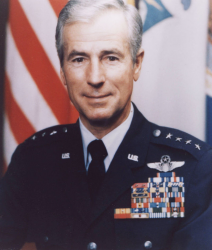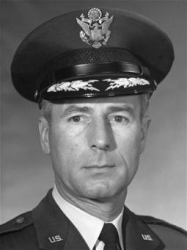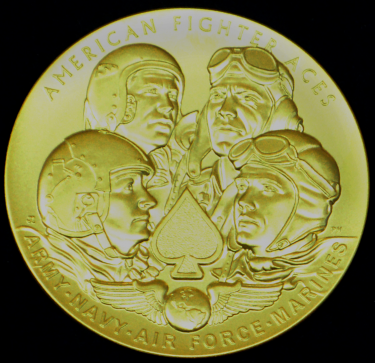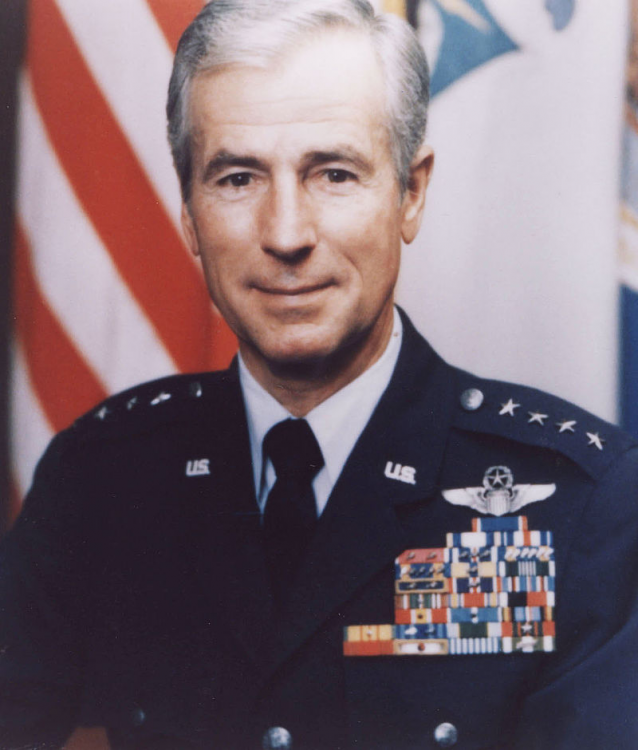
 |
|
|
||
|
James Erskine Hill |
||||
|
Engagements: • World War II (1941 - 1945)• Korean War (1950 - 1953)• Vietnam War (1960 - 1973) |
||||
| Biography: | ||||
|
James Erskine Hill James Erskine Hill was born on 1 October 1921 in Stillwater, OK. He graduated from Stillwater High School and then attended Oklahoma State University and the University of Oklahoma. He entered the U.S. Army Air Corps as an aviation cadet in March 1942 and was commissioned as a Second Lieutenant in the U.S. Army Air Corps with the rating of Pilot upon completing pilot training in February 1943. In December 1943, Hill was assigned as Pilot of a P-47 Thunderbolt fighter with the 388th Fighter Squadron, 365th Fighter Group, Ninth Air Force, U.S. Army Air Forces in the European Theater of Operations. On 18 April 1945, then-MAJ Hill was leading a squadron of 11 P-47's. MAJ Hill encountered, and aggressively attacked, a numerically superior force of German ME-109's. Demonstrating sound judgment and daring courage, MAJ Hill personally destroyed 3 enemy aircraft and expertly led and directed his squadron mates in the destruction of 7 more in the air, 2 on the ground, and 1 damaged on the ground. MAJ Hill's squadron accounted for all the German aircraft it encountered without the loss of a single P-47 or pilot. MAJ Hill's skill, courageous actions and extraordinary heroism that day earned him the U.S. Army's second highest award for valor, the Distinguished Service Cross. Hill became a World War II ace, credited with 5 enemy aircraft shot down while flying 127 combat missions. He returned to the U.S. in September 1945 and was released from active duty in December 1945. He then became Commander of a P-51 Mustang squadron in the Oklahoma Air National Guard.In November 1948, Hill returned to active duty and served as a Flight Commander with the 3525th Pilot Training Wing, Williams Air Force Base, AZ. In August 1950, he was transferred to the 8th Fighter-Bomber Wing at Itazuke Air Base, Japan, and began flying combat missions in Korea. He later joined Headquarters Fifth Air Force, Osan Air Base, Korea, where he served as Operations Officer and Chief, Fighter Operations Division, Directorate of Operations. He flew 128 combat missions as an F-80 pilot, downing one enemy aircraft. Hill returned to the U.S. in September 1951 and was reassigned to the 3525th Pilot Training Wing as an Operations and Training Staff Officer. He transferred to Fort Bragg, NC, in January 1952 for duty with the Joint Tactical Air Support Board. In April 1953, he departed for England to attend the Royal Air Force Flying College at Royal Air Force Station Manby as an exchange officer. Upon graduation, Hill joined the 20th Fighter-Bomber Wing, Royal Air Force Station Wethersfield, England, and served as an Operations Staff Officer and Assistant Director of Operations for 10 months. In February 1955, he was transferred to the 79th Fighter-Bomber Squadron, Royal Air Force Station Woodbridge, England, where he served as Squadron and Base Commander. In May 1956, he rejoined the 20th Fighter-Bomber Wing and served as Director of Operations and as Deputy Commander. Hill returned to the U.S. in July 1957 and was assigned as Senior Air Force Advisor for the 121st Tactical Fighter Wing, Ohio Air National Guard, at Lockbourne Air Force Base, OH. From August 1960 to August 1963, he was assigned to Headquarters U.S. Air Force in the Office of the Deputy Chief of Staff, Operations, in the Directorate of Manpower and Organization, as Chief of Contract Services Branch, and later served as Deputy Chief of Organizational Requirements Division. He attended the Industrial College of the Armed Forces during 1963-64, and was awarded a Bachelor of Science degree in Business Administration from the University of Maryland in 1964. In August 1964, Hill went to Clark Air Base, Republic of the Philippines, where he was Deputy Commander for Operations of the 405th Fighter Wing; in September 1964, he became Commander of the Wing; and in January 1966, was reassigned on base to Headquarters Thirteenth Air Force as Deputy Chief of Staff, Plans and Operations. Hill returned to the U.S. in July 1966 and Commanded the 3615th Pilot Training Wing, Craig Air Force Base, AL. In July 1967, he was assigned as Commander of the 40th Air Division at Wurtsmith Air Force Base, MI, and in June 1968, he assumed Command of the 825th Strategic Aerospace Division at Little Rock Air Force Base, AR. In January 1970, he became Commander of the 42nd Air Division, Blytheville Air Force Base, AR. General Hill was named Deputy Assistant to the Secretary of Defense (Atomic Energy) in July 1971. He remained in that post until June 1972 when he was transferred to the United Kingdom as Commander of the Third Air Force. In November 1973, he returned to Headquarters U.S. Air Force to be Assistant Deputy Chief of Staff for Plans and Operations. In September 1974, Hill was assigned as Commander-in-Chief, Alaskan Command, with additional duty as Commander, Alaskan North American Air Defense Region, with headquarters at Elmendorf Air Force Base, AK. He became Commander of Alaskan Air Command after dissolution of ALCOM and assimilation of its responsibilities by AAC in July 1975. Hill was transferred during October 1976 to Barksdale Air Force Base, LA, where, as Commander of Eighth Air Force, he was responsible for all Strategic Air Command operations and bases in the eastern half of the U.S. Lt Gen Hill was Vice Commander-in-Chief, SAC Headquarters at Offutt Air Force Base, NE, from 1 July to 6 December 1977. On 21 December 1977, Hill was promoted to the four-star rank of General and named Commander-in-Chief of North American Air Defense Command (NORAD) and the U.S. Air Force Aerospace Defense Command, with consolidated headquarters at Peterson Air Force Base, Colorado Springs, CO. General Hill retired from the Air Force on 31 December 1979. Medals, Awards and Badges Army Distinguished Service Cross Distinguished Service Cross Citation The President of the United States of America, authorized by Act of Congress July 9, 1918, takes pleasure in presenting the Distinguished Service Cross to Major (Air Corps) James Erskine Hill (AFSN: FR-20741/ASN: 0-673734), United States Army Air Forces, for extraordinary heroism in connection with military operations against an armed enemy while serving as Pilot of a P-47 Thunderbolt of the 388th Fighter Squadron, 365th Fighter Group, NINTH Air Force, in action while leading a squadron of eleven P-47's on 18 April 1945. On this date, Major Hill encountered and aggressively attacked a numerically superior force of ME-109's. Demonstrating cool judgment and daring courage, he personally destroyed three enemy aircraft and expertly led and directed his squadron mates in the destruction of seven more in the air, two on the ground, and one damaged on the ground, thus accounting for all the enemy aircraft encountered without loss of a single P-47 or pilot. Major Hill's heroism, skill, and complete disregard for his personal safety reflect highest credit upon himself and the Armed Forces of the United States. General Orders: Headquarters, U.S. Army Air Forces in Europe, General Orders No. 134 (October 14, 1945) Honors The General James E. Hill Lifetime Space Achievement Award is presented annually by the Space Foundation to an outstanding individual who has distinguished himself/herself through lifetime contributions to the welfare or betterment of humankind through the exploration, development and use of space, or the use of space technology, information, themes or resources in academic, cultural, industrial or other pursuits of broad benefit to humanity. Gen Hill was the chairman of the Space Foundation from 1986 - 1999. Recipients include: ● 2013 Neil Armstrong and Sally Ride, Ph.D. Congressional Gold Medal The Congressional Gold Medal, created by the U.S. Mint, is the highest civilian honor Congress can give on behalf of the American people. On 20 May 2015, leaders from the U.S. House of Representatives and Senate presented the Congressional Gold Medal [see photo] to the American Fighter Aces Association at the U.S. Capitol Visitor Center Emancipation Hall. More than 60,000 American fighter pilots engaged in aerial combat during World War I, World War II, the Korean War and the Vietnam War. Of those pilots, only 1,447 earned the title of fighter “Ace” by downing at least five enemy aircraft. General James Erskine Hill was one of them, having been credited with 5 aircraft shot down in aerial combat, qualifying him as an “Ace”. At the time of the presentation of the Medal, only 75 of those Aces remained alive. In Retirement After his retirement, Hill served as President of the Colorado Springs Chamber of Commerce. Death and Burial General James Erskine Hill died of Leukemia on 20 May 1999. He is buried at the United States Air Force Academy Cemetery in Colorado Springs, El Paso County, CO. |
||||
| Honoree ID: 739 | Created by: MHOH | |||
Ribbons
Medals
Badges
Honoree Photos
 |  |  |
 |  |
 |


